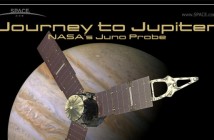Jupiter’s largest moon is the Ganymede. It is also the largest satellite in the Solar System. The largest moon of Jupiter is larger than Pluto and Mercury, and slightly smaller than Mars. Additionally, this moon can be misjudged as a planet if you are orbiting the sun, instead of Jupiter.
Largest Moon of Jupiter
The largest moon of Jupiter is about 4.5 billion years old, which is about the same age with Jupiter. Ganymede is the 7th moon on Jupiter and the 3rd Galilean satellite to be found outward from the planet. It orbits around 1.070 million km or 665, 000 miles around Jupiter. Also, Ganymede takes seven Earth days to finish orbiting Jupiter.
Ganymede’s radius is 2, 631.2 km or 1, 635 miles. Because of its size, it can be viewed on Earth with the naked eye. According to early astronomical records of the Chinese, the discovery of the moons of Jupiter started with the observation of Ganymede. Although the largest moon is larger than Mercury, Ganymede has only half the mass of Mercury and has a low density.
The daytime temperatures of Ganymede on the surface average from 171F to -297F, and drop to -193C at night time. This is a clear indication that there is no any living organism that thrives in Ganymede.
Ganymede Discovery
The largest moon of Jupiter was discovered in January 7, 1610 by Galileo Galelei. He discovered Ganymede along with the three other Jovian moons. It was also the time when the moon is discovered to be orbiting the planet other than planet Earth. His discovery of the Ganymede and Jovian moons led to the understanding that planets revolve around the sun, instead of the Solar System revolving around the Earth.
Jupiter’s largest moon that time was not yet Ganymede. Galileo called this Jupiter III, but the numerical naming was abandoned on mid 1800s, so the moon was named after the Trojan prince in the Greek Mythology, Ganymede. The counterpart of Jupiter in Roman mythology is Zeus, who has been carried by Ganymede to Olympus in the form of a giant eagle.
Ganymede Explorations
There are human spacecrafts that flew to Jupiter and its moons. In 1973, Pioneer 10 arrived in Ganymede, followed by Pioneer 11 in 1974. Voyagers 1 and 2 have also taken pictures of Ganymede when they pass by the moon. Only the Galileo spacecraft has taken detailed images when it passed as low as 261 km or 162 miles over the Galilean moon’s surface.
The atmosphere of Ganymede consists of thin oxygen, which is not capable of supporting life. Also, Ganymede is the only satellite in the Solar System with a magnetosphere, aside from Earth. A magnetosphere is a comet-like region wherein charged particles are deflected or trapped.
The magnetosphere of Ganymede is embedded with Jupiter’s magnetosphere. Also, 40% of Ganymede’s surface is covered with cratered dark regions. The remaining 60% of the moon’s surface is covered with a light grooved terrain, forming intricate patterns across the moon. Also, it has been believed that Ganymede has a 124 miles saltwater ocean below its surface.



